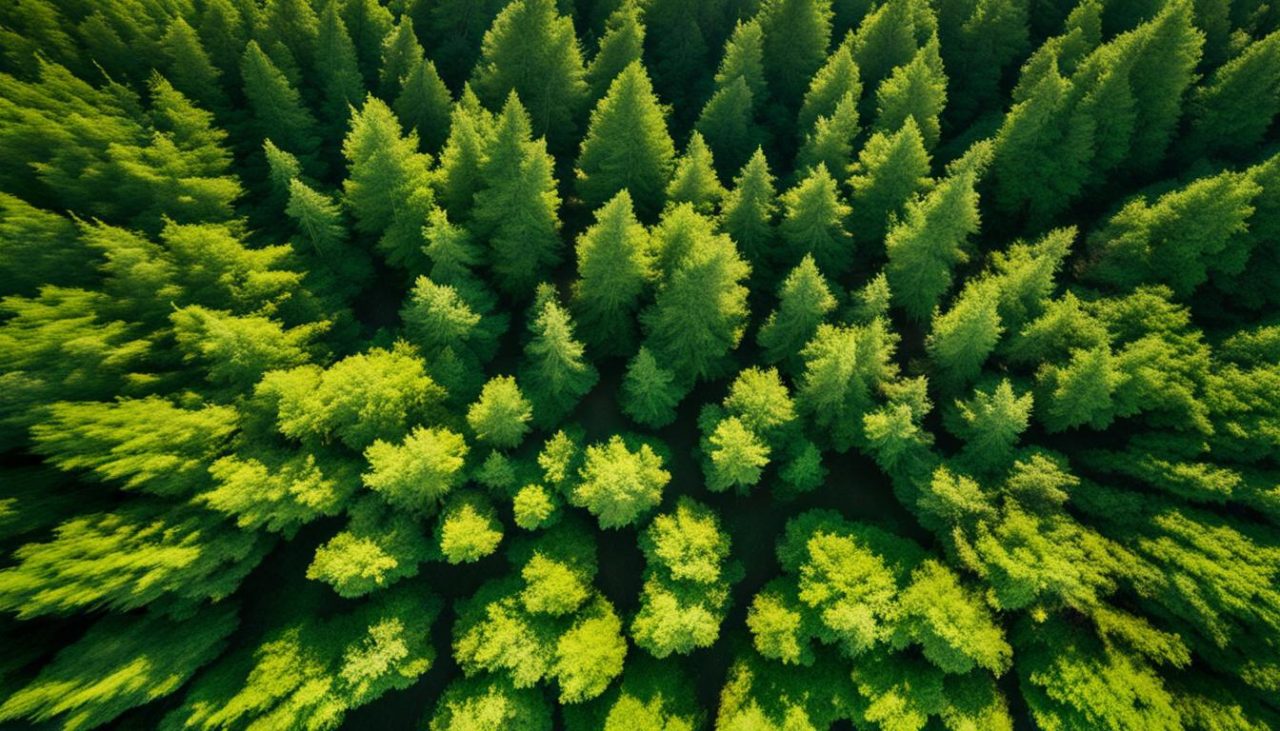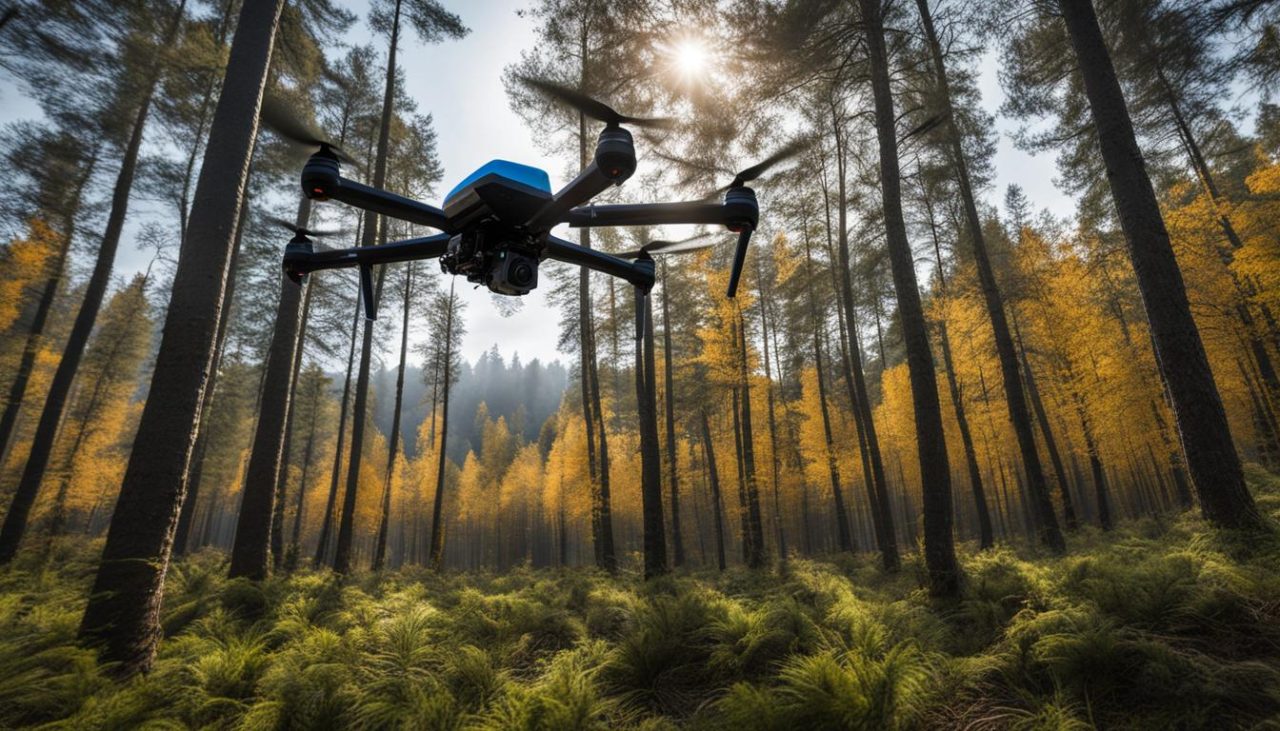As wildlife enthusiasts, we are always looking for innovative ways to monitor and protect Michigan’s beautiful landscapes and diverse wildlife. That’s why we are thrilled to introduce our state-of-the-art wildlife monitoring drones. These advanced aerial monitoring systems are revolutionizing the way we understand and manage our natural resources, providing us with real-time data and invaluable insights.
Our wildlife monitoring drones in Michigan are equipped with cutting-edge technology, including high-resolution cameras and remote sensing capabilities. This allows us to conduct nature surveillance, assess forest health, track wildlife populations, and contribute to environmental conservation efforts. From the lush forests and pristine parks to the vast fishing grounds, our drones are helping us uncover hidden treasures and better protect Michigan’s abundant biodiversity.
Key Takeaways:
- Wildlife monitoring drones in Michigan offer a new perspective for assessing habitats and tracking wildlife populations.
- These drones aid in combating illegal poaching and wildlife trafficking.
- They provide real-time monitoring and data analysis, enabling timely intervention for habitat restoration and sustainable land management.
- Drones play a crucial role in promoting environmental conservation and preserving Michigan’s natural resources.
The Benefits of Wildlife Monitoring Drones in Michigan
Wildlife monitoring drones in Michigan offer numerous benefits for wildlife conservation and management. These advanced aerial monitoring systems provide a unique perspective that allows for better assessment of habitats, population surveys, and tracking of wildlife. By leveraging remote sensing technology, Michigan can enhance its wildlife management practices and contribute to the preservation of its natural resources.
One of the key advantages of wildlife monitoring drones is their ability to assess forest health, detect pests or diseases, and identify areas in need of restoration or conservation efforts. These drones can capture high-resolution imagery and collect data from hard-to-reach locations, providing valuable insights into the condition of ecosystems. With this information, environmental conservationists and wildlife management agencies can make informed decisions and take targeted actions to protect wildlife.
“Drones have transformed the way we monitor and manage wildlife in Michigan. With their aerial perspective and advanced capabilities, we can now collect data more efficiently, track wildlife movements, and identify areas in need of conservation efforts.” – Michigan Department of Natural Resources
Furthermore, wildlife monitoring drones play a crucial role in combating illegal poaching and wildlife trafficking. By deploying drones to monitor hunting lands and sensitive wildlife habitats, authorities can collect real-time data on activities and respond swiftly to any threats. This proactive approach helps protect endangered species and ensures the sustainability of Michigan’s wildlife ecosystem.
With their advanced monitoring equipment and aerial data collection technology, wildlife monitoring drones are revolutionizing wildlife conservation and management practices in Michigan. By leveraging these innovative solutions, the state can achieve a more comprehensive understanding of its natural resources, implement effective conservation strategies, and preserve its wildlife for future generations.
Agriculture and Land Management with Drones in Michigan
Wildlife monitoring drones in Michigan have not only revolutionized wildlife conservation but also transformed agriculture and land management practices in the state. These advanced aerial monitoring systems, equipped with state-of-the-art technology, offer precision farming techniques and real-time monitoring capabilities.
For farmers, drones provide valuable data on soil health, crop growth, and pest infestations, allowing for more informed decision-making and optimized resource utilization. The ability to collect this data quickly and efficiently enables farmers to identify potential issues early on and take action to minimize crop losses and increase yields.
In land management, drones play a crucial role in wildlife population surveys, habitat assessment, and monitoring. They provide an aerial perspective that allows conservationists to map ecosystems, identify areas in need of restoration, and monitor the impact of natural disasters on habitats. By leveraging drone technology, Michigan can implement targeted conservation efforts and ensure the preservation of its diverse ecosystems.
| Benefits of Agriculture and Land Management with Drones in Michigan |
|---|
| Improved crop management: Drones collect precise data on crop health, enabling farmers to optimize irrigation, fertilization, and pest control. |
| Sustainable practices: By monitoring soil health and crop growth, drones promote sustainable agriculture by reducing the use of chemicals and fertilizers. |
| Efficient resource utilization: Real-time monitoring allows farmers to identify areas of low productivity or excessive resource consumption, leading to more efficient land management. |
| Targeted conservation efforts: Drones aid in habitat assessment and monitoring, enabling conservationists to focus their efforts on areas in need of restoration and protection. |
By integrating drone technology into agriculture and land management practices, Michigan can achieve sustainable and environmentally conscious practices. These advanced monitoring equipment, coupled with aerial data collection technology, provide valuable insights for decision-makers and contribute to the long-term preservation of Michigan’s natural resources.
Transforming Habitat Development and Restoration in Michigan
Drones have emerged as a transformative tool in habitat development and restoration efforts in Michigan. With their bird’s eye view and advanced capabilities, drones are revolutionizing the way conservationists identify areas in need of restoration and target their efforts more effectively. The use of drones in mapping ecosystems, assessing the impact of natural disasters on habitats, and planting trees with precision is transforming the landscape of habitat development and restoration in Michigan.
One of the key advantages of using drones in habitat development and restoration is their cost-effectiveness and efficiency. Drones provide a cost-effective solution for conducting habitat surveys and monitoring. They can cover large areas in a shorter amount of time compared to traditional methods, saving both time and resources. Additionally, drones equipped with advanced monitoring equipment allow conservationists to collect real-time data and make informed decisions for effective restoration strategies.
The use of drones in habitat development and restoration also contributes to the preservation of Michigan’s precious ecosystems. By accurately mapping ecosystems and identifying areas in need of restoration, drones help conserve biodiversity and protect natural resources. They provide valuable insights into habitat degradation and enable conservationists to prioritize restoration efforts where they are most needed. With their ability to reach inaccessible areas, drones play a crucial role in preserving Michigan’s diverse habitats and ensuring their long-term sustainability.
| Benefits of Using Drones in Habitat Development and Restoration | Examples |
|---|---|
| Cost-effectiveness and efficiency | – Conducting habitat surveys – Monitoring restoration progress |
| Real-time data collection | – Identifying areas in need of restoration – Assessing habitat degradation |
| Precise mapping and planning | – Mapping ecosystems – Planning restoration strategies |
| Preservation of biodiversity | – Conserving endangered species habitats – Protecting natural resources |
As drone technology continues to advance, its role in habitat development and restoration will only become more significant. With further improvements in aerial data collection technology and remote sensing capabilities, drones will enable even more precise habitat mapping and restoration planning. The integration of artificial intelligence and machine learning algorithms will further enhance data analysis and decision-making, leading to more sustainable and effective restoration efforts. The future of habitat development and restoration in Michigan looks promising with the transformative power of drones.

Real-Time Monitoring and Data Analysis with Wildlife Monitoring Drones
Wildlife monitoring drones in Michigan provide a powerful tool for real-time monitoring and data analysis in environmental conservation and wildlife management. Equipped with advanced sensors and cameras, these drones collect valuable data on various aspects of the ecosystem, including crop health, habitat degradation, and environmental factors. This data is crucial for making informed decisions and implementing sustainable land management practices.
The use of artificial intelligence (AI) and machine learning techniques enables efficient analysis of the collected data. By processing the information gathered by the drones, we can detect early signs of environmental issues, such as pests or habitat degradation, and take timely action to mitigate these challenges. Real-time monitoring and data analysis contribute to more effective conservation efforts, ensuring the preservation of Michigan’s wildlife and natural resources.
“Real-time monitoring allows for early detection of issues like pests or habitat degradation, enabling timely intervention and more effective conservation efforts.”
Moreover, the data collected by wildlife monitoring drones can also aid in identifying patterns and trends over time. By analyzing historical data, we gain valuable insights into long-term changes in the ecosystem, which can inform future conservation strategies and policy-making. The combination of real-time monitoring and historical data analysis provides a comprehensive understanding of the dynamics of Michigan’s wildlife habitats.
The following table showcases the key advantages of real-time monitoring and data analysis with wildlife monitoring drones:
| Advantages | Description |
|---|---|
| Early detection of environmental issues | Real-time monitoring allows for the prompt identification of pests, habitat degradation, and other environmental challenges, enabling timely intervention and conservation efforts. |
| Informed decision-making | Data analysis provides valuable insights that inform decision-making processes for sustainable land management practices, wildlife conservation strategies, and resource allocation. |
| Long-term trend analysis | Historical data analysis helps identify patterns and trends in the ecosystem over time, providing valuable information for long-term conservation planning and policy development. |
| Efficient resource allocation | Real-time monitoring and data analysis allow for optimized resource allocation, ensuring effective utilization of manpower, financial resources, and conservation efforts. |
The integration of real-time monitoring and data analysis with wildlife monitoring drones in Michigan represents a groundbreaking approach to environmental conservation and wildlife management. By harnessing the power of technology, we can enhance our understanding of the ecosystem, make informed decisions, and implement sustainable practices to safeguard Michigan’s wildlife and natural resources for future generations.

Conclusion
Wildlife monitoring drones have revolutionized conservation efforts in Michigan, offering advanced monitoring equipment and aerial data collection technology. These nature surveillance drones provide a unique perspective that enables us to better assess habitats, track wildlife populations, and combat illegal activities like poaching and wildlife trafficking. By leveraging the benefits of drone technology, we can contribute to the preservation of Michigan’s natural resources and promote sustainable practices.
Not only are these drones valuable in wildlife conservation, but they also play a crucial role in agriculture and land management. With their real-time monitoring capabilities, farmers and land managers can collect data on crop health, soil conditions, and pest infestations. This allows for informed decision-making and optimized resource utilization, leading to increased efficiency and productivity.
Furthermore, wildlife monitoring drones have proven to be transformative tools in habitat development and restoration projects. Their aerial perspective allows us to identify areas in need of restoration and target our efforts more effectively. Drones can be used for mapping ecosystems, assessing the impact of natural disasters, and even precision planting of trees. By utilizing these advanced monitoring systems, we can cost-effectively restore habitats and contribute to the preservation of Michigan’s precious ecosystems.
In conclusion, the potential of wildlife monitoring drones in Michigan is limitless. With their advanced capabilities and our commitment to environmental conservation, we can protect our wildlife, promote sustainable practices, and ensure the preservation of our natural resources for future generations. This is an exciting time for innovation and progress in the field of aerial data collection, and we are proud to be at the forefront of this technological advancement.
FAQ
What is the purpose of the drone program by the Michigan Department of Natural Resources?
The drone program is utilized for various purposes, including assessing forest health, searching for wildlife, and promoting state forests, parks, and fishing.
When did the drone program start and how has it expanded since then?
The drone program started in 2016 with three drones and has since expanded to include seven licensed pilots and 10 drones of different sizes and capabilities.
How have drones been used in joint projects with the National Audubon Society?
Drones have been used in joint projects with the National Audubon Society to search for tern nests and survey muskrat huts.
What other purposes have drones been used for?
Drones have been used for mapping and assessing forest health, as well as for promotional videos of state parks.
What value does the Michigan DNR see in drones for wildlife monitoring and management?
The Michigan DNR sees the value of drones in wildlife monitoring and management and continues to explore new possibilities for their use.
What benefits do wildlife monitoring drones offer for wildlife conservation and management?
Wildlife monitoring drones provide an aerial perspective that allows for better assessment of habitats, population surveys, and tracking of wildlife.
How do drones contribute to combatting illegal poaching and wildlife trafficking?
Drones aid in combatting illegal poaching and wildlife trafficking by helping authorities monitor hunting lands.
How do drones revolutionize agriculture and land management practices in Michigan?
Drones offer precision farming techniques and real-time monitoring capabilities, allowing for more informed decision-making and optimized resource utilization in agriculture and land management.
What role do drones play in habitat development and restoration efforts?
Drones provide a bird’s eye view that enables conservationists to identify areas in need of restoration and target their efforts more effectively.
How do wildlife monitoring drones contribute to data collection and analysis?
Equipped with sensors and cameras, drones collect data on crop health, habitat degradation, and other environmental factors. This data can be analyzed using AI and machine learning techniques for more informed decision-making.
What are the benefits of using wildlife monitoring drones for real-time monitoring?
Real-time monitoring allows for early detection of issues like pests or habitat degradation, enabling timely intervention and more effective conservation efforts.
How do wildlife monitoring drones contribute to environmental conservation in Michigan?
Wildlife monitoring drones offer advanced capabilities that enable better assessment, monitoring, and decision-making, promoting sustainable practices and protecting Michigan’s wildlife and natural resources.


